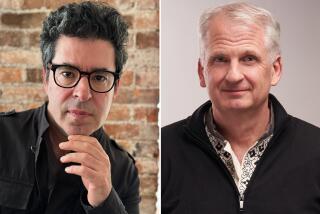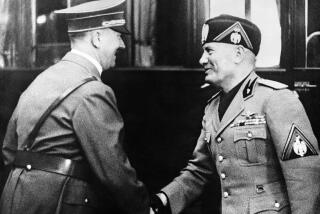A New Day for Il Duce
- Share via
PREDAPPIO, Italy — It began quietly, without warning. One morning, three young skinheads on a secret mission entered the crypt, donned black capes and took turns standing at grim attention by their hero’s tomb.
The next day, another stone-faced trio took up the 11-hour watch, and before many people noticed, the stealth vigil had become a daily routine. Today, nearly a year later, the ritual is an established fact: Benito Mussolini, the long-disgraced fascist dictator, has a posthumous honor guard.
Mayor Ivo Marcelli, a former Communist, is outraged. Having such an infamous native son is awkward enough, he complains, but the honor guard has this little town under a kind of paramilitary siege. Over the mayor’s protests, the silent men in capes keep coming from all over Italy and now number about 400.
Mussolini is enjoying a revival, and its strength is evident far beyond his grave. Fifty-seven years after he was shot dead by Italian partisans while trying to flee the country and strung upside-down in a piazza in Milan, Italy’s shame about its vanquished World War II ruler is yielding to the curiosity and fascination of generations born since.
As a political force in Italy, fascism may be as dead as Mussolini himself. But with mainstream nationalists holding power in Rome and gaining strength across Europe, historians are reassessing his legacy, and restraints on the country’s long-hidden fascist subculture are loosening.
Despite a law that bans public glorification of fascism, shops and flea markets all over Italy sell everything from T-shirts to bottles of wine bearing the boulder-jawed image of Il Duce. For those who love kitsch, there’s a Snoopy dog with a menacing glare on his face and a black truncheon in his paw.
Exhibits of fascist-era art and schoolbooks draw crowds. Newsstands offer a 15-video set of Mussolini’s speeches, and a televised interview with his daughter drew 3.5 million viewers last fall--a huge audience here for such programming.
The dictator’s homes are being restored and opened to the paying public. A dedicated traveler can now trace Mussolini’s life from the farmhouse where he was born here in 1883; to Villa Torlonia, his Rome residence when he ruled Italy from 1922 to 1943; to Villa Feltrinelli, now a five-star hotel on picturesque Lake Garda, where he led a tiny rump republic under German army protection until his capture and execution in 1945.
And if Guido Costa, the mayor of Tremestieri Etneo, gets his way, nostalgia tourists will be able to add his Sicilian town to the itinerary and stroll down the proposed “Via Benito Mussolini--Statesman.” Italy’s resurgent interest in its most notorious 20th century figure defies the politically correct portrayal of his one-party regime as an unmitigated disaster. That Cold War perspective was shaped by the Communists who led the anti-fascist partisan struggle and the Socialists and Christian Democrats who dominated the country’s postwar politics.
In that view, fascism was an unbroken plague of mass marches, Pharaonic public works, press censorship, secret police, imperial conquest and anti-Semitic laws, capped by a disastrous alliance with Nazi Germany that provoked an Allied invasion and left Italy in ruins. Mussolini’s party was banned after the war, and a 1952 law prohibited any public call for its revival.
Over the last decade, since corruption scandals brought down Italy’s center-left establishment and opened the way for right-wing parties to vie for power, a more complex view of fascism, emphasizing its benefits as well as its flaws, has gained ground.
Volumes by Renzo De Felice and other Italian historians have emphasized that Mussolini was beloved during most of his heyday for modernizing the country, defending family values, suppressing the Mafia and making the trains run on time. That popularity broke down only with the devastation of the war, they point out.
The election of a center-right government under media magnate Silvio Berlusconi last May has further eroded the anti-fascist taboos.
But it has also kept Mussolini’s emboldened but tiny band of loyalists out on the fringe.
Gianfranco Fini, whose National Alliance is the reformed heir to the Fascist Party, has embraced the political mainstream to become Berlusconi’s deputy prime minister. Seeking respectability as Italy’s delegate to a European Union panel, Fini in January retracted his 1994 characterization of Mussolini as the century’s greatest statesman.
Many Italians welcome all these changes as evidence that fascist political power is irretrievable and that a more balanced look at its historical and cultural imprint is now possible.
“Paradoxically, as fascism recedes over the historical horizon, it is becoming more of a folkloric phenomenon,” said Franco Pavoncello, a political science professor at Rome’s John Cabot University. “Before, it was unacceptable, hidden. Now you see people trying to establish a connection with the past.”
To others, however, the fascination with Mussolini borders on a rehabilitation that would be impossible in Germany for Adolf Hitler, his Nazi protege and wartime ally.
“Even the heat cannot suppress the shiver provoked by the open respect given to Italy’s biggest war criminal,” James Walston, a British-born political scientist who is active in Italian politics, remarked after visiting Mussolini’s tomb last summer. “The reason for this revival, this acceptability, is that younger people do not know what fascism was really like.”
‘Fascism Was Never
Fully Defeated’
That’s because Italy, which finished the war in the Allied camp, failed to come to terms with its own war crimes, as the Germans did, or prosecute its worst offenders, Walston said.
“Fascism was never fully defeated,” he said.
Perhaps no place in Italy stirs such debate more easily than Predappio, a farming village that in 1925 was transformed by its native son into a model of town planning and that feels the conflicting impulses of a nation reappraising his legacy.
“Fascism was an important world event. It made Italy an international player and cannot be erased,” said a 75-year-old retired Predappio bricklayer who identified himself only as Sergio. “But we cannot go back. No, no, no! Democracy is just fine. No one imposes anything.”
Set in rolling vineyard country near Bologna, Predappio has 6,000 inhabitants and a single piazza, surrounded by the monumental Church of St. Anthony, a hospital, a police station, the old party headquarters and the Town Hall--five institutions that helped maintain fascist control.
“Everything you see here, Mussolini created,” Pierluigi Pompignoli told a visitor during a drive through the square.
The 65-year-old merchant pointed proudly to an engraving of the fasci--the bundles of rods borne by magistrates in ancient Rome and adopted by the fascists as their party emblem--on the church facade. Right after the war, “the Communists wanted to get up there and erase it,” he said, “but the brothers formed a cordon and saved it.”
Predappio has been a battleground since. The main street, Via Roma, was renamed in honor of Giacomo Matteotti, a Socialist slain by a fascist gang in 1924. Like much of Italy after the war, the townspeople elected leftists and tried to obliterate all signs of the dictator.
In 1957, however, the town’s leaders reluctantly allowed the dictator’s rotting corpse, which had been exhumed by supporters from a grave near Milan, to be moved to the Mussolini family crypt here. The remains were placed in a large granite tomb topped with a marble bust of Il Duce and a box containing part of his brain.
From then on, Predappio has been a magnet for old comrades and young fascists in black shirts--the uniform of his party--who gather each year to sing party hymns and raise stiff-armed salutes on the anniversaries of Mussolini’s birth, death and rise to power. A guest register in the crypt bulges with comments anticipating Mussolini’s return--some expressing the sentiment that next time, there will be no mistakes.
The nationwide ban on such pro-fascist expression was never lifted, but strict enforcement is not the Italian way. As the trickle of pilgrims became a flood, town officials abandoned efforts to keep out tour buses and fascist memorabilia.
“You can call this a rehabilitation” of the dictator, declared Pompignoli, who quit the poultry business 12 years ago to cash in on the revival. His Predappio Tricolore, one of the town’s three purveyors of fascist kitsch, features the Mussolini 2002 calendar; Il Duce graces the cover, a strong man in a pith helmet astride a white horse.
Mayor Marcelli has a different take on the growing crowds. According to his surveys, 30,000 people visited Predappio in 1990, and 29,000 of them were Mussolini admirers. Today, more than 70,000 visitors come each year; most are still fascists, but a growing proportion--at least 20,000-- are “merely curious about our history,” he said.
Seeking to invert that ratio against the black-shirted pilgrims, Marcelli has announced plans to reinvent Predappio as a laboratory for examining Mussolini’s two-decade grip on Italy.
He made a modest start in 1999 by opening the dictator’s birthplace to the public--not as a shrine but as an instructive museum featuring exhibits on the regime’s use of postcards, art, architecture and sports as propaganda. Now he’s asking Parliament for funding to create a research center.
“We want to become a venue for analysis and debate on the risks and dangers of fascism,” the 51-year-old mayor said. Could fascism revive? “No, I don’t believe Italy is ripe for another old-style dictator. But we could succumb to anti-liberalism, an era of extreme intolerance.”
One sign of that threat, he warns, is that politicians on the left and right are blocking his proposal.
“The left is afraid that the right will exploit our project as an apology for fascism, and the right wants to wait until it gets control of Town Hall,” he said. A more telling sign was the deliberate omission from an art exhibit in Predappio last spring of any reference to Mussolini’s persecution of Jews or alliance with Hitler. Organizers said they wanted to avoid inflaming passions during the national election campaign.
Such was the edgy political mood that greeted Mussolini’s honor guard in June, a few weeks after Berlusconi’s landslide at the polls.
The all-male guard began with a core of young skinheads from social clubs tied to Fini’s National Alliance and the tiny Forza Nuova party, then grew by word of mouth. The participants chose capes to evade Italy’s rigid rules about who may wear uniforms and black “to show respect” for a dead hero, said Arinaldo Grazziani, the guard’s 41-year-old vice president.
Berlusconi’s government has denied supporting the guard but ignored the mayor’s call to ban it. Under the constitution, the mayor argues, the state has exclusive domain over honor guards and has authorized just two in Rome--one for the unknown soldier, one for a pair of 19th century kings entombed in the Pantheon.
To Mussolini’s heirs, the guards are volunteers on private property.
“What harm are they?” asked Guido Mussolini, the dictator’s 65-year-old grandson, who received 3,497 votes last year as Forza Nuova’s candidate for mayor of Rome. “They are not armed. They stand in that crypt for hours and hours and hours. They meditate. They come out changed, completely for the better. They don’t hate anyone anymore.”
Besides, he said, “who is greater? Those kings, or Mussolini?”
Among outsiders, the guards are nearly as silent off duty as on. One, a 48-year-old businessman, said they are sworn to secrecy about their politics, the better to “keep this act of love for Benito Mussolini unspoiled” by any appearance of partisanship. A wide range of Italians, he said, admire Il Duce as a stronger, more honest ruler than any Italy has had since.
Anything said about the guards can be provocative. In response to the mayor’s protests, Guido Mussolini once made the claim that the silent skinheads foster a mood of reverence in the dictator’s crypt and discourage vandalism.
An anonymous vandal rose to the challenge, slipping into the crypt on a cold February morning and stealing the guest register.
Aha! cried the mayor. Unguarded, the tomb had been trouble-free since a 1971 bombing.
“Now the book has been taken from right in front of their eyes,” he said. “This is ultimate proof that this so-called honor guard is nothing but a folkloric stunt.”
More to Read
Sign up for Essential California
The most important California stories and recommendations in your inbox every morning.
You may occasionally receive promotional content from the Los Angeles Times.










